Economics Report: Retention and Graduation Rates in US Online Colleges
VerifiedAdded on 2023/04/26
|10
|1846
|146
Report
AI Summary
This report examines the relationship between retention rates and graduation rates in US online colleges using a simple linear regression model. The study analyzes data from 29 online colleges, providing descriptive statistics for both variables, including mean, standard deviation, and skewness. A scatter plot visually represents the correlation between the two rates. The regression analysis determines the estimated equation for predicting graduation rates based on retention rates, revealing a positive and statistically significant association. The report further assesses the goodness of fit of the regression equation and highlights performance concerns at specific institutions. The findings confirm the importance of student retention for achieving high graduation rates. The report concludes with policy implications and recommendations for improving student success in online higher education.
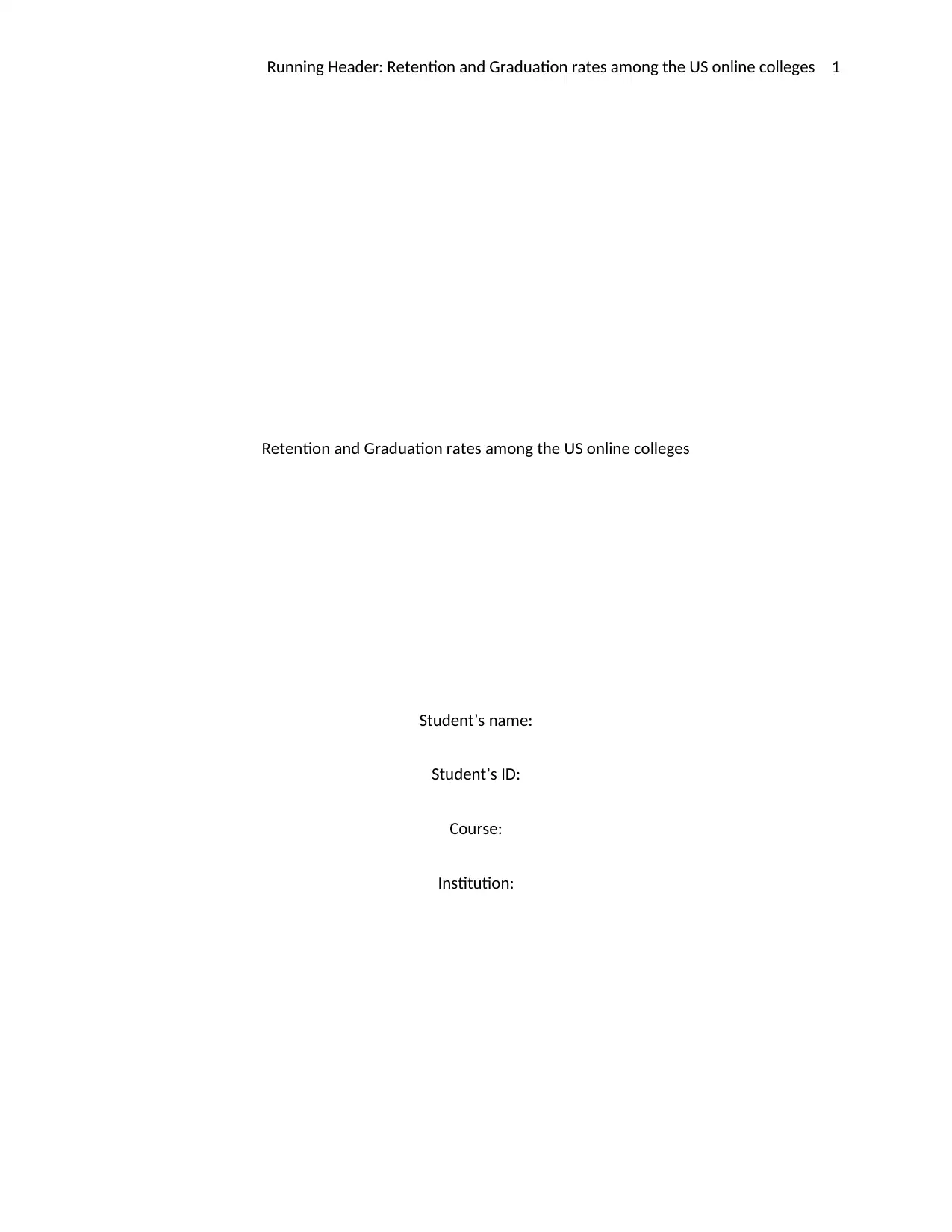
Running Header: Retention and Graduation rates among the US online colleges 1
Retention and Graduation rates among the US online colleges
Student’s name:
Student’s ID:
Course:
Institution:
Retention and Graduation rates among the US online colleges
Student’s name:
Student’s ID:
Course:
Institution:
Paraphrase This Document
Need a fresh take? Get an instant paraphrase of this document with our AI Paraphraser
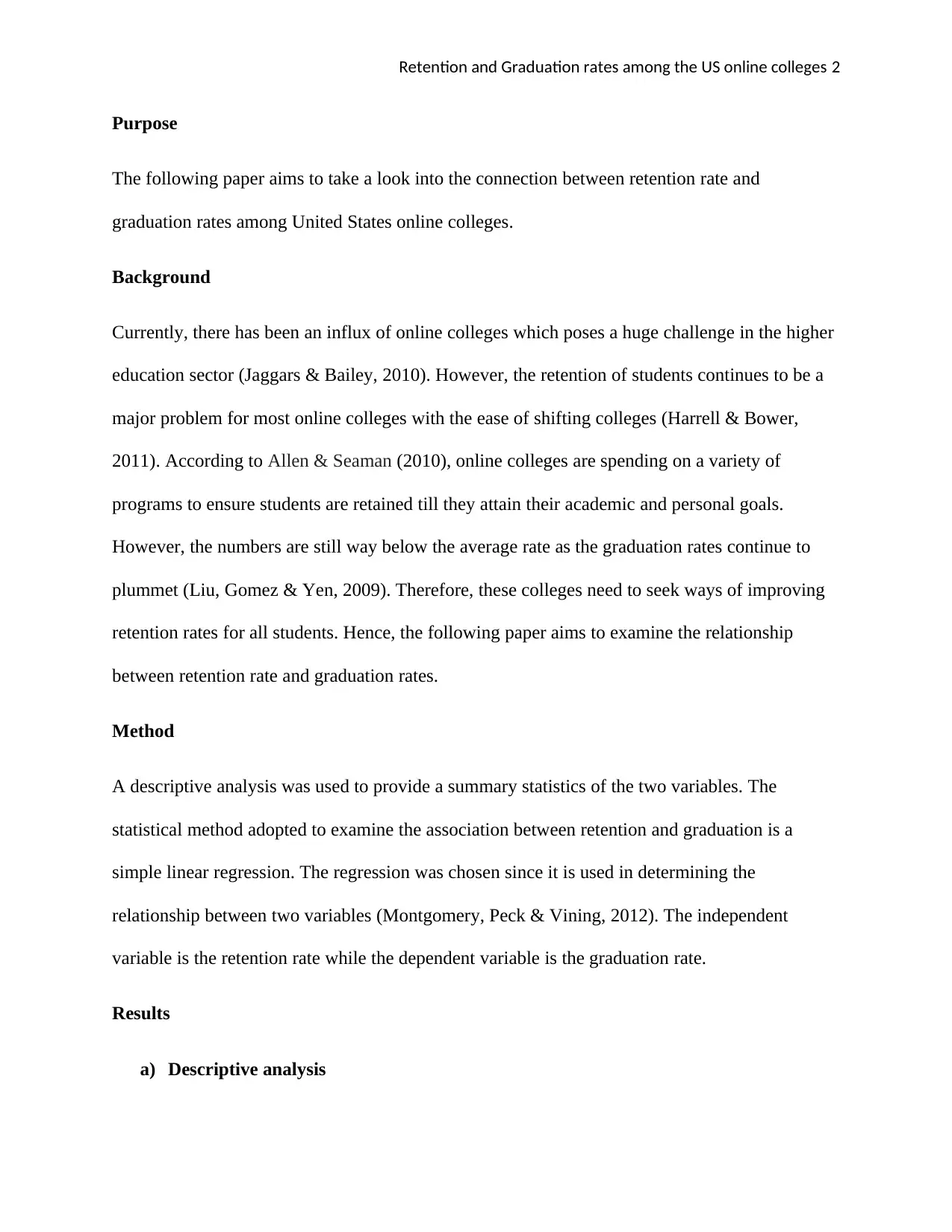
Retention and Graduation rates among the US online colleges 2
Purpose
The following paper aims to take a look into the connection between retention rate and
graduation rates among United States online colleges.
Background
Currently, there has been an influx of online colleges which poses a huge challenge in the higher
education sector (Jaggars & Bailey, 2010). However, the retention of students continues to be a
major problem for most online colleges with the ease of shifting colleges (Harrell & Bower,
2011). According to Allen & Seaman (2010), online colleges are spending on a variety of
programs to ensure students are retained till they attain their academic and personal goals.
However, the numbers are still way below the average rate as the graduation rates continue to
plummet (Liu, Gomez & Yen, 2009). Therefore, these colleges need to seek ways of improving
retention rates for all students. Hence, the following paper aims to examine the relationship
between retention rate and graduation rates.
Method
A descriptive analysis was used to provide a summary statistics of the two variables. The
statistical method adopted to examine the association between retention and graduation is a
simple linear regression. The regression was chosen since it is used in determining the
relationship between two variables (Montgomery, Peck & Vining, 2012). The independent
variable is the retention rate while the dependent variable is the graduation rate.
Results
a) Descriptive analysis
Purpose
The following paper aims to take a look into the connection between retention rate and
graduation rates among United States online colleges.
Background
Currently, there has been an influx of online colleges which poses a huge challenge in the higher
education sector (Jaggars & Bailey, 2010). However, the retention of students continues to be a
major problem for most online colleges with the ease of shifting colleges (Harrell & Bower,
2011). According to Allen & Seaman (2010), online colleges are spending on a variety of
programs to ensure students are retained till they attain their academic and personal goals.
However, the numbers are still way below the average rate as the graduation rates continue to
plummet (Liu, Gomez & Yen, 2009). Therefore, these colleges need to seek ways of improving
retention rates for all students. Hence, the following paper aims to examine the relationship
between retention rate and graduation rates.
Method
A descriptive analysis was used to provide a summary statistics of the two variables. The
statistical method adopted to examine the association between retention and graduation is a
simple linear regression. The regression was chosen since it is used in determining the
relationship between two variables (Montgomery, Peck & Vining, 2012). The independent
variable is the retention rate while the dependent variable is the graduation rate.
Results
a) Descriptive analysis
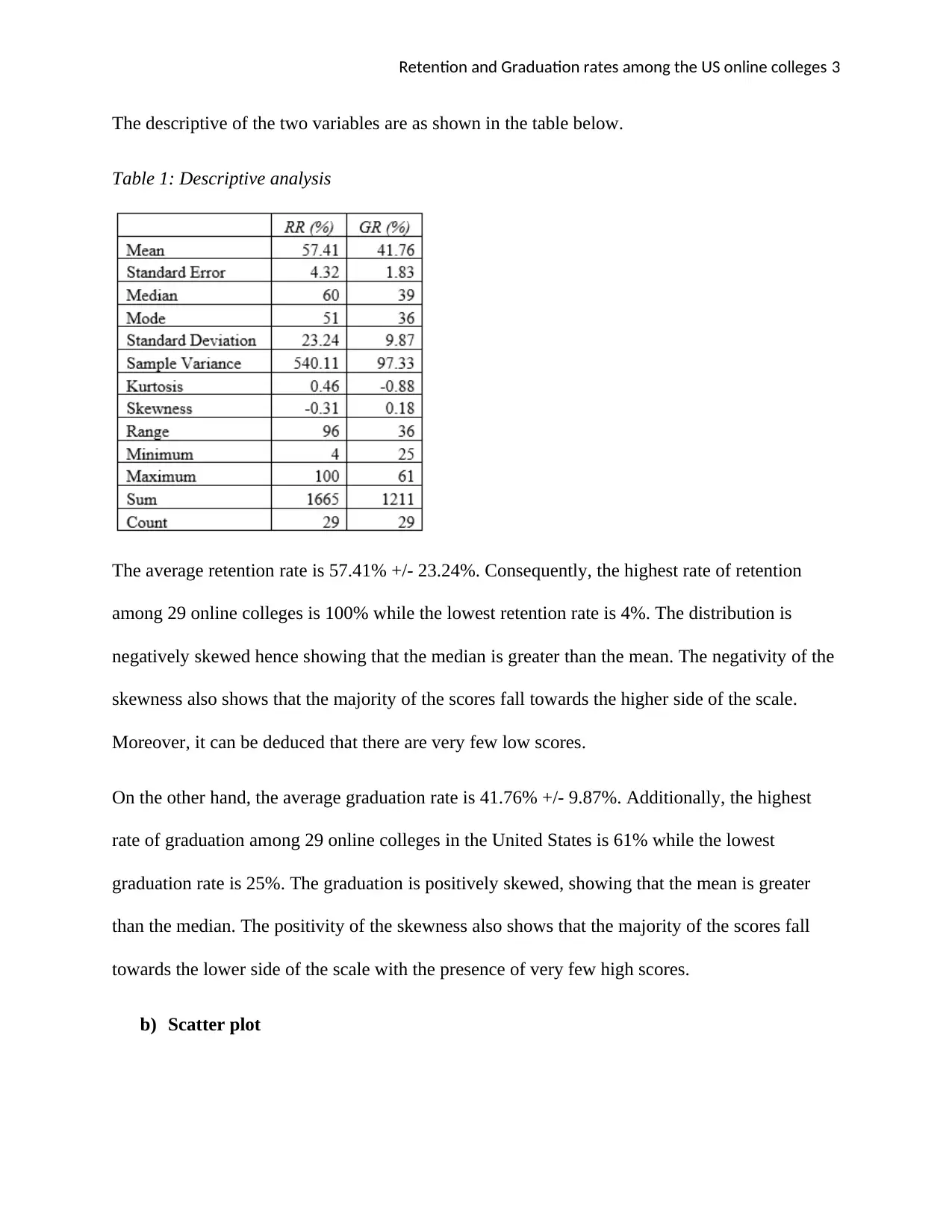
Retention and Graduation rates among the US online colleges 3
The descriptive of the two variables are as shown in the table below.
Table 1: Descriptive analysis
The average retention rate is 57.41% +/- 23.24%. Consequently, the highest rate of retention
among 29 online colleges is 100% while the lowest retention rate is 4%. The distribution is
negatively skewed hence showing that the median is greater than the mean. The negativity of the
skewness also shows that the majority of the scores fall towards the higher side of the scale.
Moreover, it can be deduced that there are very few low scores.
On the other hand, the average graduation rate is 41.76% +/- 9.87%. Additionally, the highest
rate of graduation among 29 online colleges in the United States is 61% while the lowest
graduation rate is 25%. The graduation is positively skewed, showing that the mean is greater
than the median. The positivity of the skewness also shows that the majority of the scores fall
towards the lower side of the scale with the presence of very few high scores.
b) Scatter plot
The descriptive of the two variables are as shown in the table below.
Table 1: Descriptive analysis
The average retention rate is 57.41% +/- 23.24%. Consequently, the highest rate of retention
among 29 online colleges is 100% while the lowest retention rate is 4%. The distribution is
negatively skewed hence showing that the median is greater than the mean. The negativity of the
skewness also shows that the majority of the scores fall towards the higher side of the scale.
Moreover, it can be deduced that there are very few low scores.
On the other hand, the average graduation rate is 41.76% +/- 9.87%. Additionally, the highest
rate of graduation among 29 online colleges in the United States is 61% while the lowest
graduation rate is 25%. The graduation is positively skewed, showing that the mean is greater
than the median. The positivity of the skewness also shows that the majority of the scores fall
towards the lower side of the scale with the presence of very few high scores.
b) Scatter plot
⊘ This is a preview!⊘
Do you want full access?
Subscribe today to unlock all pages.

Trusted by 1+ million students worldwide
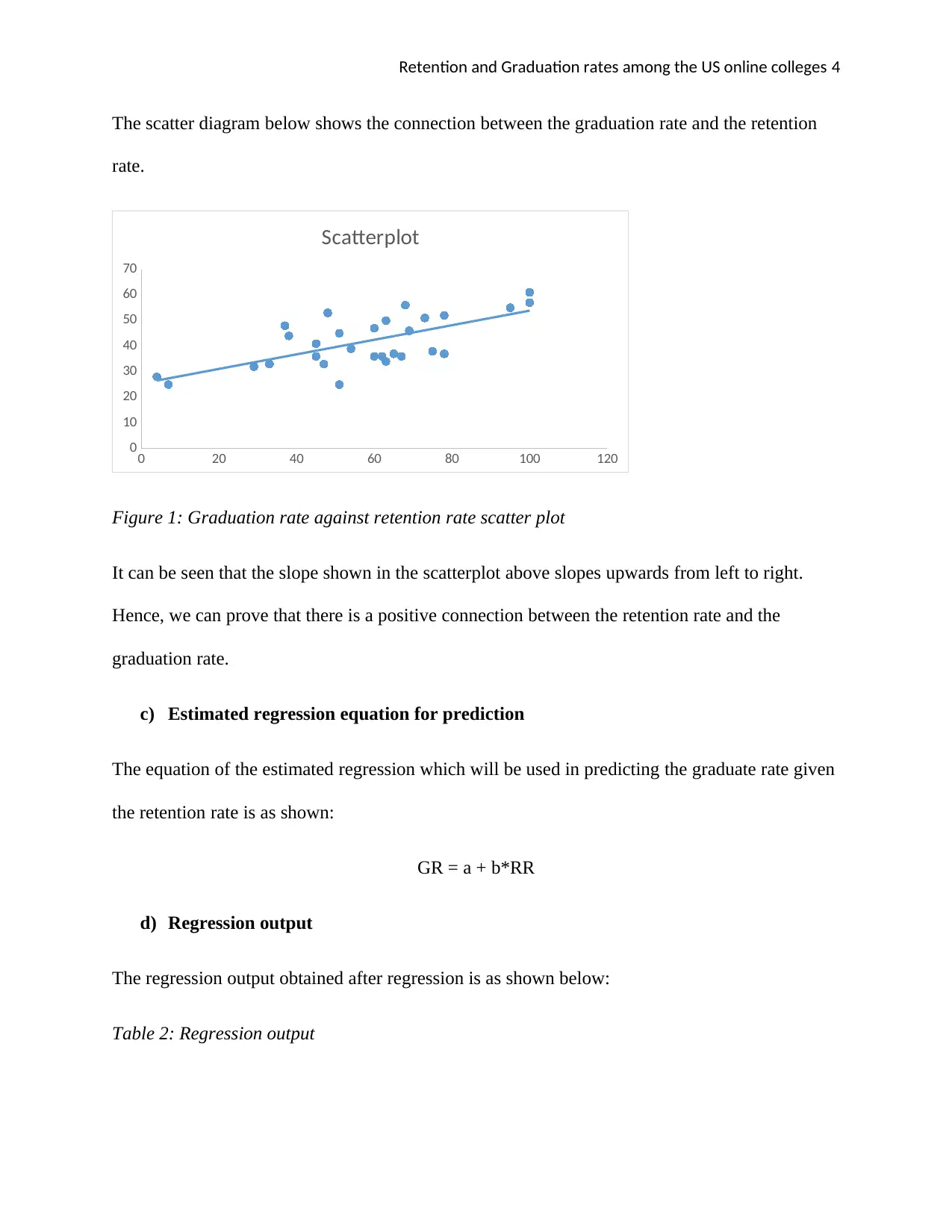
Retention and Graduation rates among the US online colleges 4
The scatter diagram below shows the connection between the graduation rate and the retention
rate.
0 20 40 60 80 100 120
0
10
20
30
40
50
60
70
Scatterplot
Figure 1: Graduation rate against retention rate scatter plot
It can be seen that the slope shown in the scatterplot above slopes upwards from left to right.
Hence, we can prove that there is a positive connection between the retention rate and the
graduation rate.
c) Estimated regression equation for prediction
The equation of the estimated regression which will be used in predicting the graduate rate given
the retention rate is as shown:
GR = a + b*RR
d) Regression output
The regression output obtained after regression is as shown below:
Table 2: Regression output
The scatter diagram below shows the connection between the graduation rate and the retention
rate.
0 20 40 60 80 100 120
0
10
20
30
40
50
60
70
Scatterplot
Figure 1: Graduation rate against retention rate scatter plot
It can be seen that the slope shown in the scatterplot above slopes upwards from left to right.
Hence, we can prove that there is a positive connection between the retention rate and the
graduation rate.
c) Estimated regression equation for prediction
The equation of the estimated regression which will be used in predicting the graduate rate given
the retention rate is as shown:
GR = a + b*RR
d) Regression output
The regression output obtained after regression is as shown below:
Table 2: Regression output
Paraphrase This Document
Need a fresh take? Get an instant paraphrase of this document with our AI Paraphraser
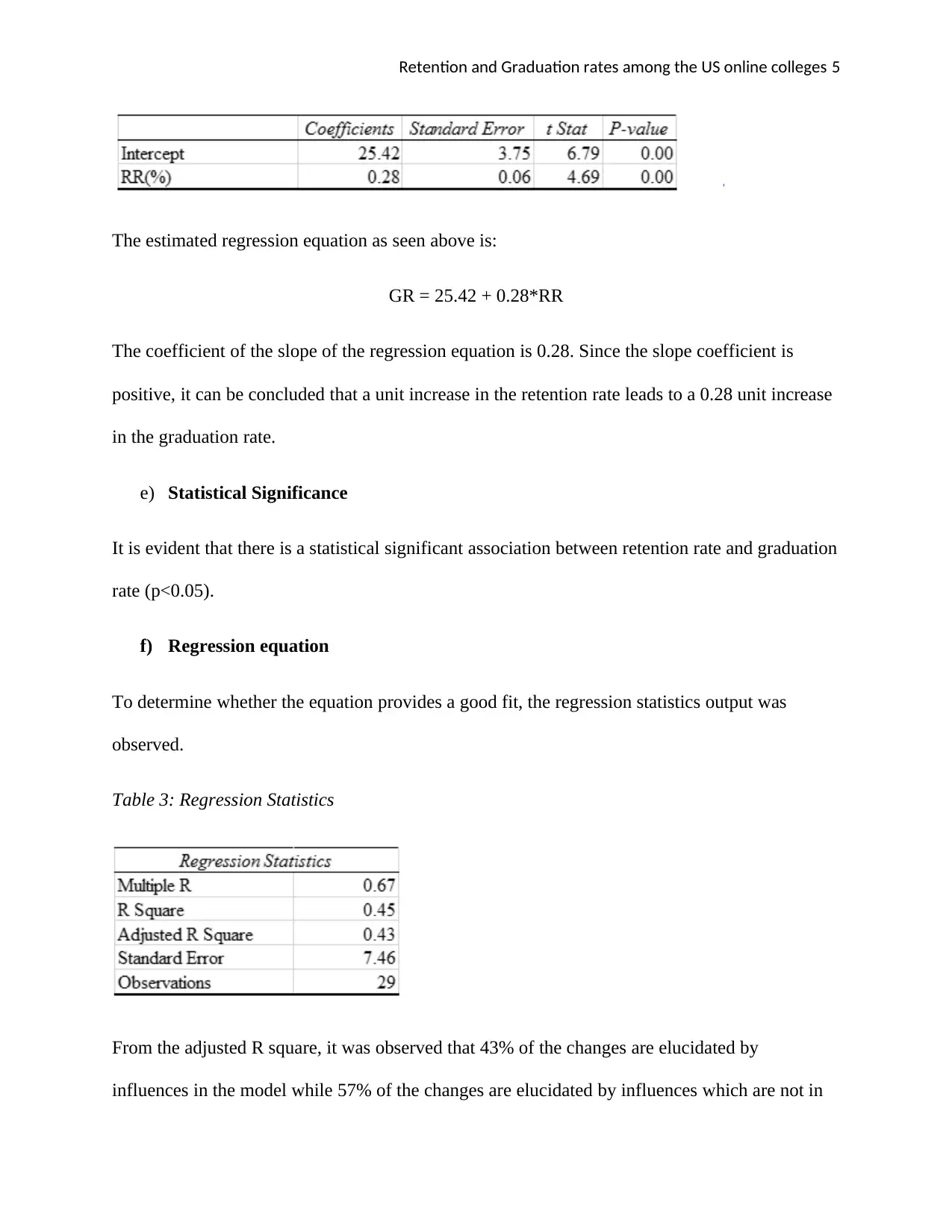
Retention and Graduation rates among the US online colleges 5
The estimated regression equation as seen above is:
GR = 25.42 + 0.28*RR
The coefficient of the slope of the regression equation is 0.28. Since the slope coefficient is
positive, it can be concluded that a unit increase in the retention rate leads to a 0.28 unit increase
in the graduation rate.
e) Statistical Significance
It is evident that there is a statistical significant association between retention rate and graduation
rate (p<0.05).
f) Regression equation
To determine whether the equation provides a good fit, the regression statistics output was
observed.
Table 3: Regression Statistics
From the adjusted R square, it was observed that 43% of the changes are elucidated by
influences in the model while 57% of the changes are elucidated by influences which are not in
The estimated regression equation as seen above is:
GR = 25.42 + 0.28*RR
The coefficient of the slope of the regression equation is 0.28. Since the slope coefficient is
positive, it can be concluded that a unit increase in the retention rate leads to a 0.28 unit increase
in the graduation rate.
e) Statistical Significance
It is evident that there is a statistical significant association between retention rate and graduation
rate (p<0.05).
f) Regression equation
To determine whether the equation provides a good fit, the regression statistics output was
observed.
Table 3: Regression Statistics
From the adjusted R square, it was observed that 43% of the changes are elucidated by
influences in the model while 57% of the changes are elucidated by influences which are not in
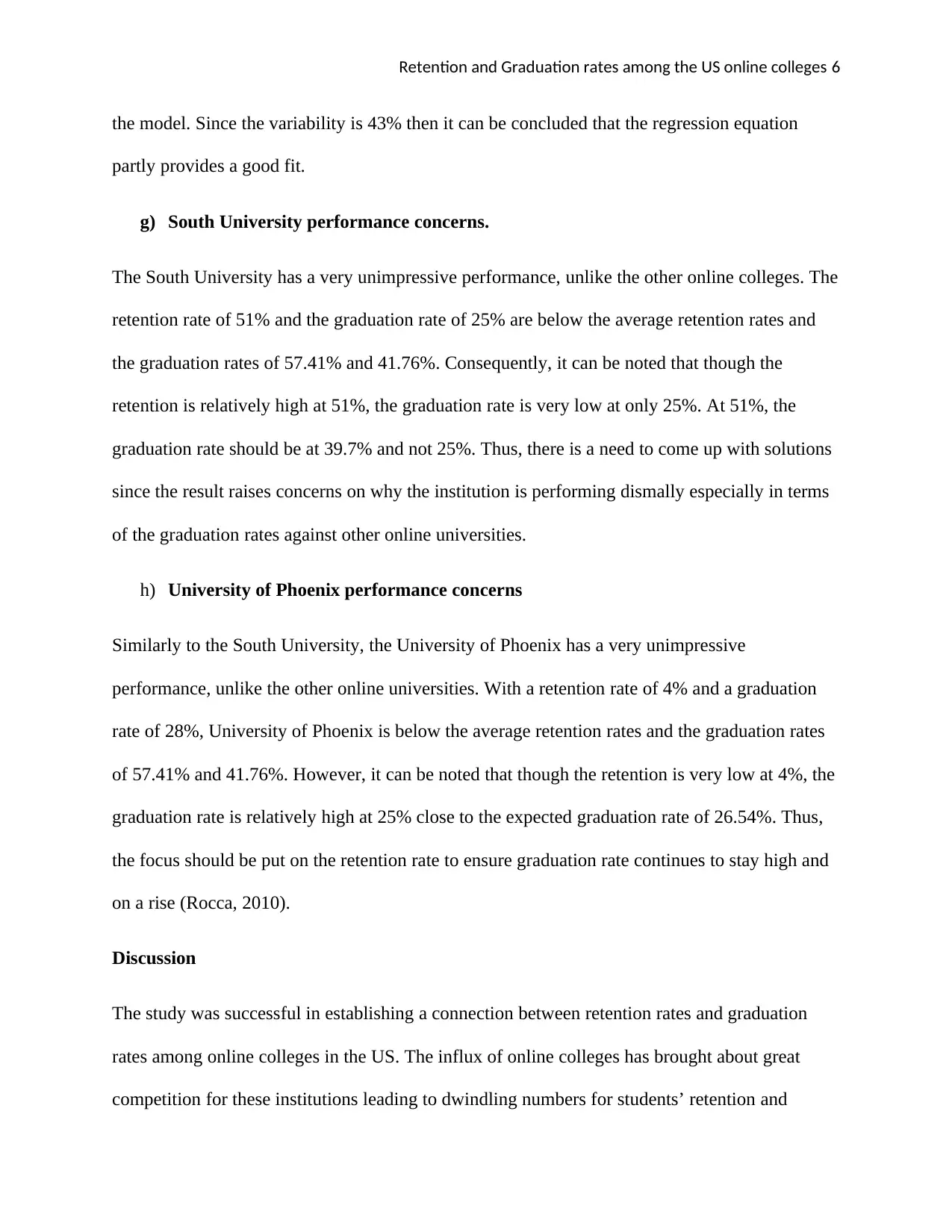
Retention and Graduation rates among the US online colleges 6
the model. Since the variability is 43% then it can be concluded that the regression equation
partly provides a good fit.
g) South University performance concerns.
The South University has a very unimpressive performance, unlike the other online colleges. The
retention rate of 51% and the graduation rate of 25% are below the average retention rates and
the graduation rates of 57.41% and 41.76%. Consequently, it can be noted that though the
retention is relatively high at 51%, the graduation rate is very low at only 25%. At 51%, the
graduation rate should be at 39.7% and not 25%. Thus, there is a need to come up with solutions
since the result raises concerns on why the institution is performing dismally especially in terms
of the graduation rates against other online universities.
h) University of Phoenix performance concerns
Similarly to the South University, the University of Phoenix has a very unimpressive
performance, unlike the other online universities. With a retention rate of 4% and a graduation
rate of 28%, University of Phoenix is below the average retention rates and the graduation rates
of 57.41% and 41.76%. However, it can be noted that though the retention is very low at 4%, the
graduation rate is relatively high at 25% close to the expected graduation rate of 26.54%. Thus,
the focus should be put on the retention rate to ensure graduation rate continues to stay high and
on a rise (Rocca, 2010).
Discussion
The study was successful in establishing a connection between retention rates and graduation
rates among online colleges in the US. The influx of online colleges has brought about great
competition for these institutions leading to dwindling numbers for students’ retention and
the model. Since the variability is 43% then it can be concluded that the regression equation
partly provides a good fit.
g) South University performance concerns.
The South University has a very unimpressive performance, unlike the other online colleges. The
retention rate of 51% and the graduation rate of 25% are below the average retention rates and
the graduation rates of 57.41% and 41.76%. Consequently, it can be noted that though the
retention is relatively high at 51%, the graduation rate is very low at only 25%. At 51%, the
graduation rate should be at 39.7% and not 25%. Thus, there is a need to come up with solutions
since the result raises concerns on why the institution is performing dismally especially in terms
of the graduation rates against other online universities.
h) University of Phoenix performance concerns
Similarly to the South University, the University of Phoenix has a very unimpressive
performance, unlike the other online universities. With a retention rate of 4% and a graduation
rate of 28%, University of Phoenix is below the average retention rates and the graduation rates
of 57.41% and 41.76%. However, it can be noted that though the retention is very low at 4%, the
graduation rate is relatively high at 25% close to the expected graduation rate of 26.54%. Thus,
the focus should be put on the retention rate to ensure graduation rate continues to stay high and
on a rise (Rocca, 2010).
Discussion
The study was successful in establishing a connection between retention rates and graduation
rates among online colleges in the US. The influx of online colleges has brought about great
competition for these institutions leading to dwindling numbers for students’ retention and
⊘ This is a preview!⊘
Do you want full access?
Subscribe today to unlock all pages.

Trusted by 1+ million students worldwide
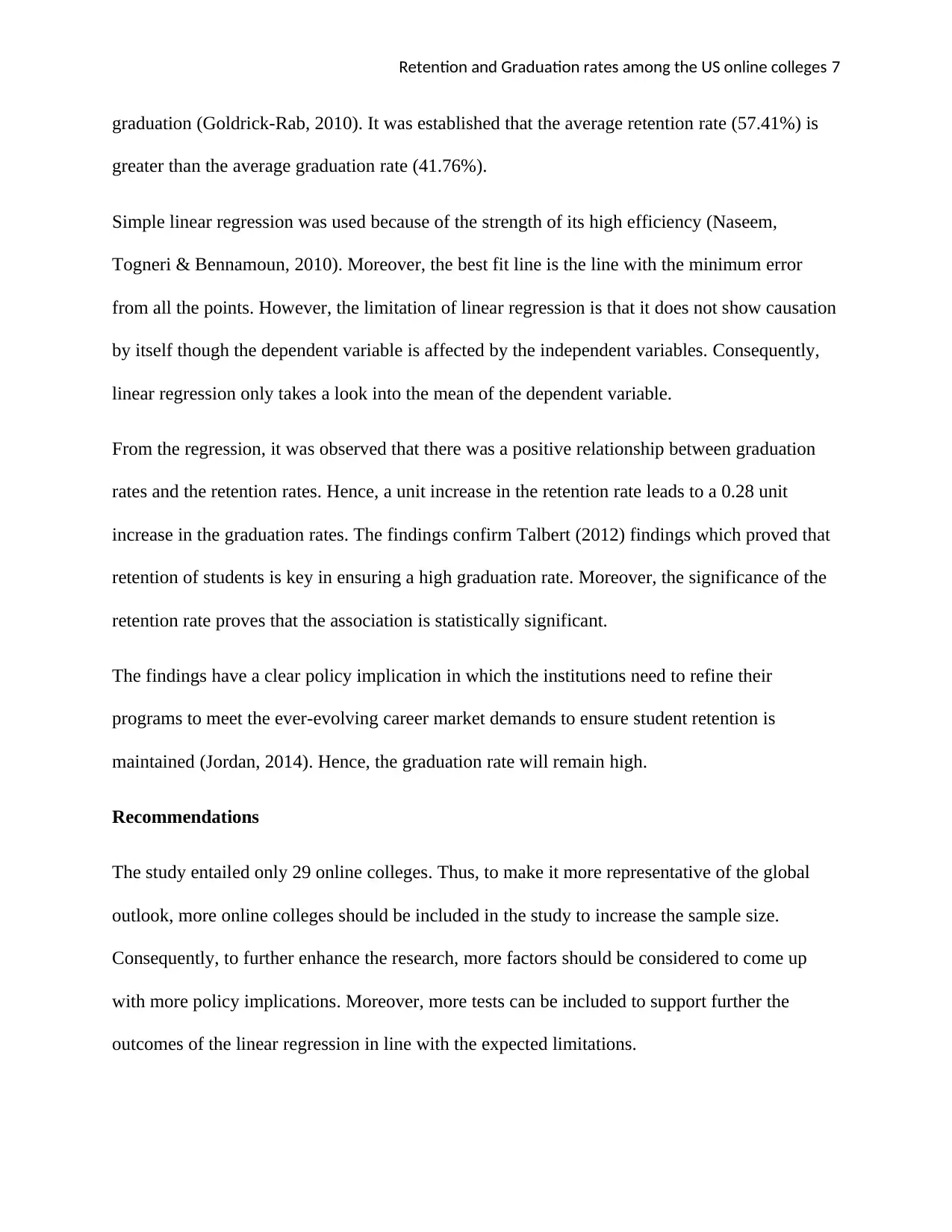
Retention and Graduation rates among the US online colleges 7
graduation (Goldrick-Rab, 2010). It was established that the average retention rate (57.41%) is
greater than the average graduation rate (41.76%).
Simple linear regression was used because of the strength of its high efficiency (Naseem,
Togneri & Bennamoun, 2010). Moreover, the best fit line is the line with the minimum error
from all the points. However, the limitation of linear regression is that it does not show causation
by itself though the dependent variable is affected by the independent variables. Consequently,
linear regression only takes a look into the mean of the dependent variable.
From the regression, it was observed that there was a positive relationship between graduation
rates and the retention rates. Hence, a unit increase in the retention rate leads to a 0.28 unit
increase in the graduation rates. The findings confirm Talbert (2012) findings which proved that
retention of students is key in ensuring a high graduation rate. Moreover, the significance of the
retention rate proves that the association is statistically significant.
The findings have a clear policy implication in which the institutions need to refine their
programs to meet the ever-evolving career market demands to ensure student retention is
maintained (Jordan, 2014). Hence, the graduation rate will remain high.
Recommendations
The study entailed only 29 online colleges. Thus, to make it more representative of the global
outlook, more online colleges should be included in the study to increase the sample size.
Consequently, to further enhance the research, more factors should be considered to come up
with more policy implications. Moreover, more tests can be included to support further the
outcomes of the linear regression in line with the expected limitations.
graduation (Goldrick-Rab, 2010). It was established that the average retention rate (57.41%) is
greater than the average graduation rate (41.76%).
Simple linear regression was used because of the strength of its high efficiency (Naseem,
Togneri & Bennamoun, 2010). Moreover, the best fit line is the line with the minimum error
from all the points. However, the limitation of linear regression is that it does not show causation
by itself though the dependent variable is affected by the independent variables. Consequently,
linear regression only takes a look into the mean of the dependent variable.
From the regression, it was observed that there was a positive relationship between graduation
rates and the retention rates. Hence, a unit increase in the retention rate leads to a 0.28 unit
increase in the graduation rates. The findings confirm Talbert (2012) findings which proved that
retention of students is key in ensuring a high graduation rate. Moreover, the significance of the
retention rate proves that the association is statistically significant.
The findings have a clear policy implication in which the institutions need to refine their
programs to meet the ever-evolving career market demands to ensure student retention is
maintained (Jordan, 2014). Hence, the graduation rate will remain high.
Recommendations
The study entailed only 29 online colleges. Thus, to make it more representative of the global
outlook, more online colleges should be included in the study to increase the sample size.
Consequently, to further enhance the research, more factors should be considered to come up
with more policy implications. Moreover, more tests can be included to support further the
outcomes of the linear regression in line with the expected limitations.
Paraphrase This Document
Need a fresh take? Get an instant paraphrase of this document with our AI Paraphraser

Retention and Graduation rates among the US online colleges 8

Retention and Graduation rates among the US online colleges 9
Reference
Goldrick-Rab, S., 2010. Challenges and opportunities for improving community college student
success. Review of Educational Research, 80(3), pp.437-469.
Harrell, I.L. and Bower, B.L., 2011. Student characteristics that predict persistence in community
college online courses. American Journal of Distance Education, 25(3), pp.178-191.
Jaggars, S. S., & Bailey, T. (2010). Effectiveness of Fully Online Courses for College Students:
Response to a Department of Education Meta-Analysis. Community College Research Center,
Columbia University.
Jordan, K., 2014. Initial trends in enrolment and completion of massive open online courses. The
International Review of Research in Open and Distributed Learning, 15(1).
Allen, I.E. and Seaman, J., 2010. Class Differences: Online Education in the United States,
2010. Sloan Consortium (NJ1).
Liu, S.Y., Gomez, J. and Yen, C.J., 2009. Community college online course retention and final
grade: Predictability of social presence. Journal of Interactive Online Learning, 8(2).
Montgomery, D.C., Peck, E.A. and Vining, G.G., 2012. Introduction to linear regression
analysis (Vol. 821). John Wiley & Sons, Hoboken, New Jersey.
Naseem, I., Togneri, R. and Bennamoun, M., 2010. Linear regression for face recognition. IEEE
transactions on pattern analysis and machine intelligence, 32(11), pp.2106-2112.
Rocca, K.A., 2010. Student participation in the college classroom: An extended multidisciplinary
literature review. Communication education, 59(2), pp.185-213.
Reference
Goldrick-Rab, S., 2010. Challenges and opportunities for improving community college student
success. Review of Educational Research, 80(3), pp.437-469.
Harrell, I.L. and Bower, B.L., 2011. Student characteristics that predict persistence in community
college online courses. American Journal of Distance Education, 25(3), pp.178-191.
Jaggars, S. S., & Bailey, T. (2010). Effectiveness of Fully Online Courses for College Students:
Response to a Department of Education Meta-Analysis. Community College Research Center,
Columbia University.
Jordan, K., 2014. Initial trends in enrolment and completion of massive open online courses. The
International Review of Research in Open and Distributed Learning, 15(1).
Allen, I.E. and Seaman, J., 2010. Class Differences: Online Education in the United States,
2010. Sloan Consortium (NJ1).
Liu, S.Y., Gomez, J. and Yen, C.J., 2009. Community college online course retention and final
grade: Predictability of social presence. Journal of Interactive Online Learning, 8(2).
Montgomery, D.C., Peck, E.A. and Vining, G.G., 2012. Introduction to linear regression
analysis (Vol. 821). John Wiley & Sons, Hoboken, New Jersey.
Naseem, I., Togneri, R. and Bennamoun, M., 2010. Linear regression for face recognition. IEEE
transactions on pattern analysis and machine intelligence, 32(11), pp.2106-2112.
Rocca, K.A., 2010. Student participation in the college classroom: An extended multidisciplinary
literature review. Communication education, 59(2), pp.185-213.
⊘ This is a preview!⊘
Do you want full access?
Subscribe today to unlock all pages.

Trusted by 1+ million students worldwide
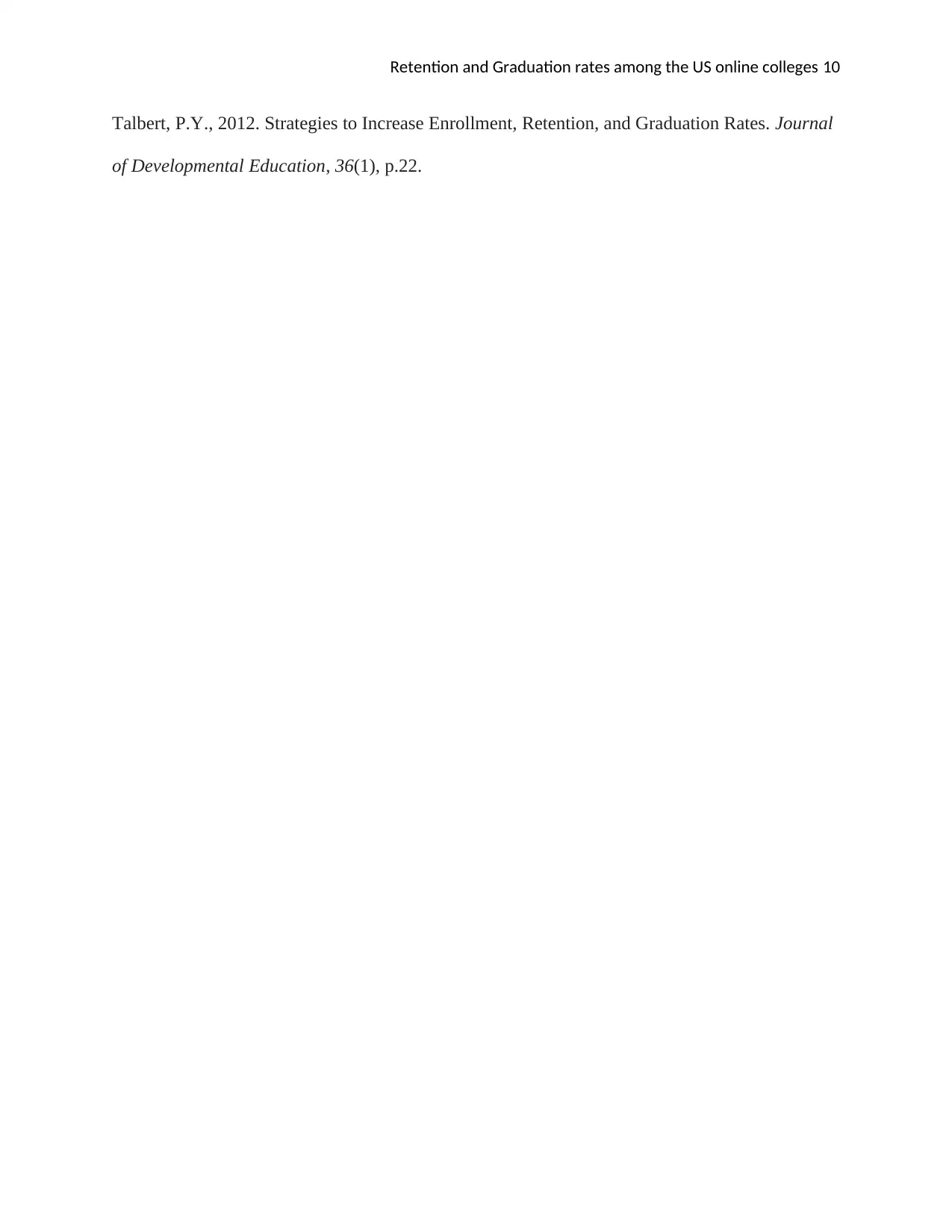
Retention and Graduation rates among the US online colleges 10
Talbert, P.Y., 2012. Strategies to Increase Enrollment, Retention, and Graduation Rates. Journal
of Developmental Education, 36(1), p.22.
Talbert, P.Y., 2012. Strategies to Increase Enrollment, Retention, and Graduation Rates. Journal
of Developmental Education, 36(1), p.22.
1 out of 10
Related Documents
Your All-in-One AI-Powered Toolkit for Academic Success.
+13062052269
info@desklib.com
Available 24*7 on WhatsApp / Email
![[object Object]](/_next/static/media/star-bottom.7253800d.svg)
Unlock your academic potential
Copyright © 2020–2026 A2Z Services. All Rights Reserved. Developed and managed by ZUCOL.





